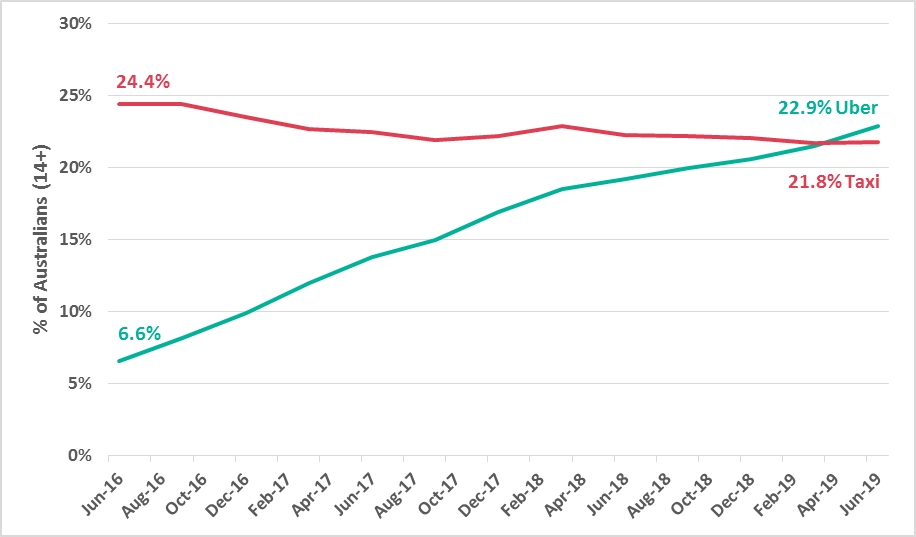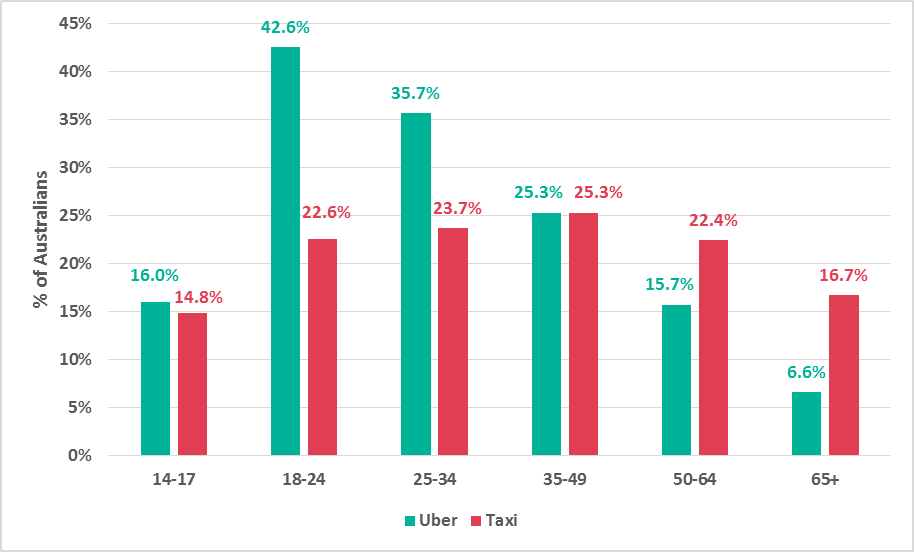Ride-sharing app Uber overtakes taxis as preferred private transport service

The latest data from Roy Morgan has shown that a greater proportion of Australians (aged 14+) are now using Uber (22.9%) compared with taxis (21.8%). This is the first data to reveal that taxis are no longer the preferred private transport service of Australians.
Over the past three years, Uber has experienced a dramatic rise in popularity. The proportion of Australians utilising the service in an average three-month period has increased from 6.6% (1.3 million) of the population, to 22.9% (4.7 million), an increase of 16.3% points (+ 3.4 million).
Although Uber is now the preferred service, the proportion of Australians using taxis has remained relatively steady in recent years, dropping only slightly from 24.4% (4.8 million) to 21.8% (4.5 million).
Percentage of Australians who used each service in an average three months

Source: Roy Morgan Single Source Australia, July 2015 – June 2019. Rolling 12-month quarterly figures. Average interviews per year n=14,733. Base: Australians aged 14+
When we look at customers by age group, we see the rising popularity of Uber being driven by younger Australians. A total of 42.6% (1 million) of those aged 18-24, and 35.7% (1.3 million) of those aged 25-34, used Uber in an average three-month period. These two age groups account for 2.3 million out of the 4.7 million Australians who use Uber in an average three-month period.
However, the usage of Uber differs markedly across age groups. While younger Australians are Uber’s best customers, Australians aged 65+ had the lowest proportion (6.6%) of Uber usage among them. Taxi usage, however, is far more consistent across age groups. Those aged 35-49 had the highest proportion of taxi usage (25.3%), with 14-17 years old’s recording the lowest (14.8%).

Source: Roy Morgan Single Source Australia, July 2018 – June 2019, n=14,383. Base: Australians aged 14+
These are the latest findings from the Roy Morgan Single Source survey derived from in-depth face-to-face interviews with 1,000 Australians each week and over 50,000 each year.
What else do we know about Uber users?
Uber users are far more likely than the average Australian to be in Generation Y and Generation Z, to be in the Young Optimism and Socially Aware Roy Morgan Value Segments, and to be in a Young Single or Young Couple household life cycle.
When it comes to health and fitness, 82% report feeling well and in good health, almost half (46%) are concerned about their sugar intake, and 30% love doing as many sports as possible.
Compared with the average Australian, Uber users are 144% more likely to have recently snowboarded, 43% more likely to be more interested in their job than their house, and 35% more likely to have recently been to the cinema.
Michele Levine, CEO of Roy Morgan, says:

“Although it comes as no real surprise, Uber has now officially become the most popular private transport service among Australians, with a total of 4.7 million Australians utilising the ride-share app in an average three-month period.
“Young Australians aged between 18-34 years old are Uber’s largest customer base. As these younger, more tech-friendly generations take up a greater proportion of the population, Uber is likely to continue to rise in popularity.
“The data shows that while taxi usage has remained relatively stable over the past few years, it is the 35-64 year age group that is taxis’ largest consumer base. As this group continues to age, it is likely we’ll see the number of taxi users continue to fall.
“When we look at Uber users within specific locations, we see Perth having the highest Uber usage of any capital city, with 32.1% of residents having recently used one. This is followed by Melbourne (31.8%) and Sydney (29.1%).”
For comments or more information please contact:
Roy Morgan - Enquiries
Office: +61 (03) 9224 5309
askroymorgan@roymorgan.com
Margin of Error
The margin of error to be allowed for in any estimate depends mainly on the number of interviews on which it is based. Margin of error gives indications of the likely range within which estimates would be 95% likely to fall, expressed as the number of percentage points above or below the actual estimate. Allowance for design effects (such as stratification and weighting) should be made as appropriate.
| Sample Size | Percentage Estimate |
| 40% – 60% | 25% or 75% | 10% or 90% | 5% or 95% | |
| 1,000 | ±3.0 | ±2.7 | ±1.9 | ±1.3 |
| 5,000 | ±1.4 | ±1.2 | ±0.8 | ±0.6 |
| 7,500 | ±1.1 | ±1.0 | ±0.7 | ±0.5 |
| 10,000 | ±1.0 | ±0.9 | ±0.6 | ±0.4 |
| 20,000 | ±0.7 | ±0.6 | ±0.4 | ±0.3 |
| 50,000 | ±0.4 | ±0.4 | ±0.3 | ±0.2 |
